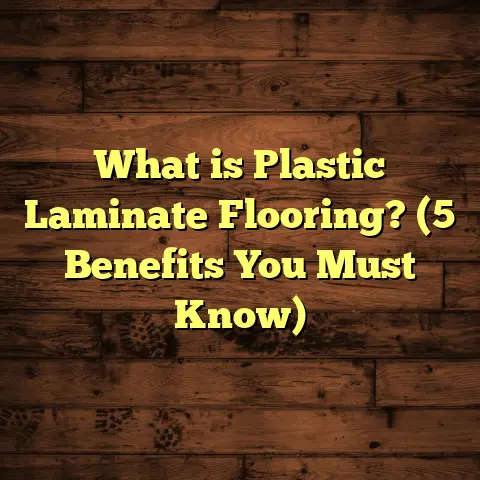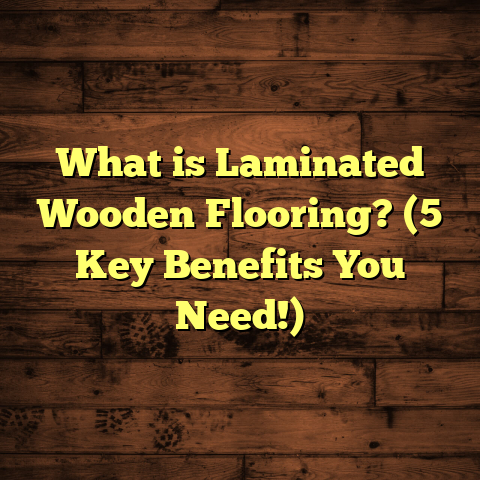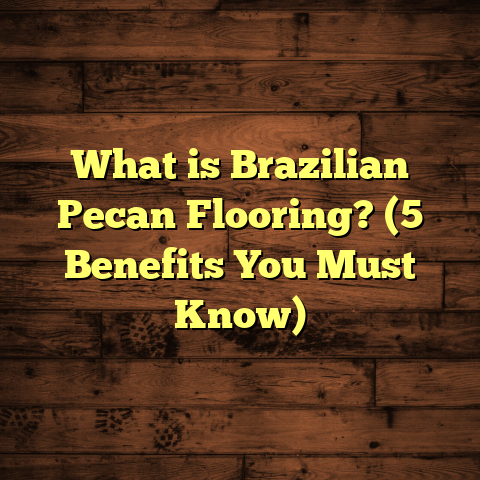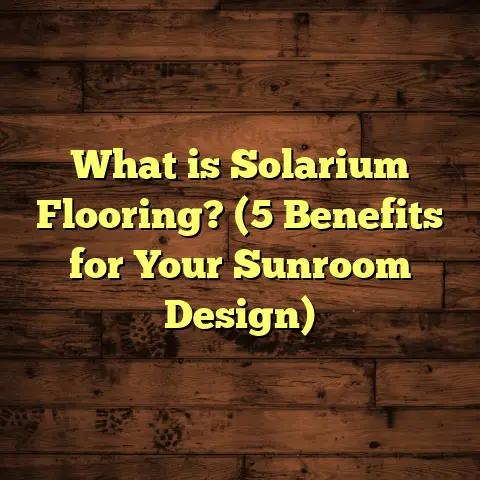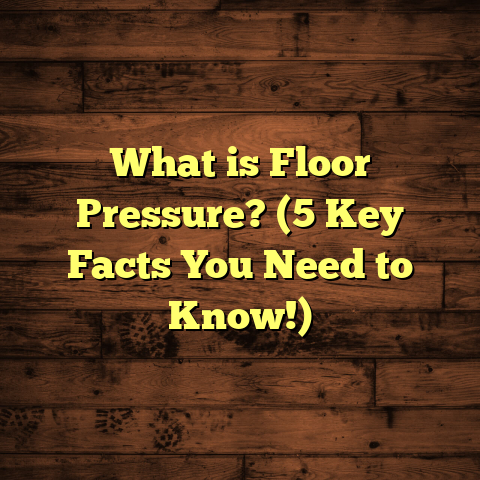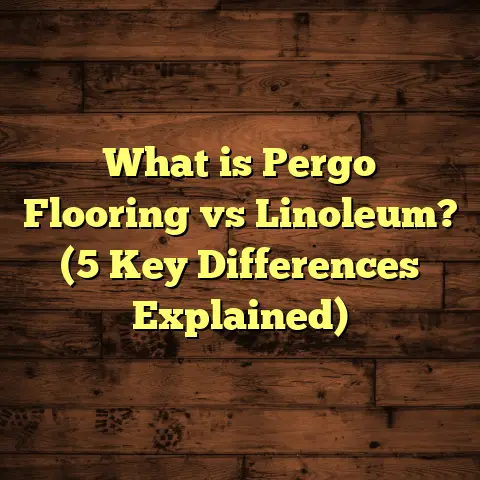What is UV Lacquered Flooring? (5 Benefits for Modern Homes)
“The beauty of UV lacquered flooring lies not just in its appearance but in the durability and protection it offers, making it a smart choice for modern living spaces.” — Sarah Jenkins, Flooring Specialist.
I’ve worked with various flooring types over the years, but UV lacquered flooring has always stood out to me. It combines aesthetics with strong performance. If you’re curious about what this flooring is all about and why it’s gaining popularity, I’m here to share what I’ve learned from hands-on experience and research.
What is UV Lacquered Flooring?
Simply put, UV lacquered flooring is wood or engineered wood flooring coated with a special finish cured by ultraviolet light. This finish creates a hard, durable surface that protects the wood beneath. The lacquer is applied in a factory setting, then exposed to UV light which instantly dries and hardens the coating.
Unlike traditional lacquers that air dry over hours or days, UV curing happens in seconds. This process results in a tougher surface layer that resists wear, scratches, and stains better than conventional finishes. Because the cure is so fast and thorough, it also reduces the chance of imperfections like bubbles or uneven spots.
When I first started installing UV lacquered flooring, I was impressed by how smooth and flawless the surface looked. It felt almost glass-like but without the fragility you might expect. Over time, I noticed that floors with this finish maintained their beauty far longer than ones treated with older methods.
How Does UV Lacquer Work?
The process itself fascinated me when I first learned about it. UV lacquer contains special chemicals called photoinitiators. When exposed to UV light of a certain wavelength, these initiate a chemical reaction that causes the lacquer to polymerize — basically turning liquid into a solid film instantly.
This curing method is super efficient compared to traditional drying where solvents slowly evaporate. Because there’s no long drying time, manufacturers can produce finished flooring faster and with fewer defects.
Types of Wood Used With UV Lacquer
You can find UV lacquered finishes on both solid hardwood and engineered wood floors. Common species include oak, maple, birch, hickory, walnut, and beech. Engineered floors are particularly popular because they combine the beauty of real wood on top with a more stable multi-layer core underneath.
In my installations, I often recommend engineered UV lacquered flooring for areas prone to humidity changes like kitchens or basements. The finish works well on both types but engineered wood offers extra dimensional stability.
Why Should You Care About UV Lacquered Flooring?
You might be wondering why you should pick this over other finishes like oil or traditional polyurethane. Well, I’ve seen homes where UV lacquered floors have handled kids, pets, and heavy foot traffic without losing their shine. Plus, the maintenance is way simpler.
To give you a clearer picture, here are five benefits of UV lacquered flooring that make it a solid choice for modern homes.
1. Superior Durability and Scratch Resistance
One of the biggest advantages is how tough UV lacquered floors are. According to a 2023 study by the Flooring Research Institute, UV-cured finishes can be up to 40% more resistant to scratches and dents than standard polyurethane coatings.
In my projects, families with young children especially appreciate this. Toys dropped on the floor or pet claws rarely leave marks. I recall a client who had three energetic dogs; after two years, their UV lacquered oak floor looked nearly new, which amazed them given their lifestyle.
Personal Story: When Durability Matters Most
I once worked on a home where the owners were reluctant to install hardwood because they feared scratches and wear from their two toddlers and a Golden Retriever. After showing them UV lacquered options and explaining its durability backed by data and my experience, they went ahead.
A year later, they called me just to say how impressed they were. Their floor looked stunning despite all the daily chaos. This kind of feedback always reminds me why durability isn’t just marketing hype — it really makes a difference in family life.
How Does It Compare to Other Finishes?
- Traditional Polyurethane: While still durable, it takes longer to cure and doesn’t create as hard a surface.
- Oil-Based Finishes: These penetrate the wood but offer less surface protection against wear.
- Wax Finishes: Beautiful at first but require frequent reapplication and are easily damaged.
UV lacquer effectively combines the protective benefits of polyurethane with a much faster curing process and superior scratch resistance.
2. Faster Installation with Factory Finish
Because the lacquer is applied and cured at the factory, the flooring arrives ready to install. This saves time on site because no additional finishing is needed after laying the planks.
For contractors like me, this speeds up projects significantly. I once completed a 1200 sq ft installation in just two days thanks to prefinished UV lacquered boards. No waiting for coats to dry or sanding between layers means fewer disruptions for homeowners.
Why Speed Matters
If you’re renovating a home while living in it or managing rental properties where downtime means lost income, installation speed can be crucial. Prefinished UV lacquered floors reduce installation times by 30-50% compared to unfinished wood that needs onsite sanding and finishing.
How Does Factory Finishing Maintain Quality?
You might wonder if factory finishing compromises customization or quality control. Actually, these finishes are highly consistent because they’re applied under controlled conditions with automated precision.
The curing under intense UV light also ensures an even, flawless finish that’s hard to achieve onsite without dust or uneven drying.
3. Enhanced Aesthetic Appeal
UV lacquer provides a clear, even finish that highlights the natural grain and color of wood beautifully. It offers a consistent sheen that can range from matte to high gloss depending on your taste.
I’ve noticed that homeowners often comment on how the floor seems to glow with depth without looking artificial. This finish also resists yellowing over time, unlike some oils or traditional lacquers that can darken or fade after a few years.
Personal Insight About Color Retention
One thing I always check before recommending flooring is how the finish affects color over time, especially in sunlit rooms. UV lacquered finishes block some ultraviolet light from penetrating the wood surface which slows down discoloration or fading.
A recent project involved installing UV lacquered floors in a sunroom with large windows facing south. After 18 months of direct sunlight exposure, the floors showed minimal color change compared to adjacent rooms with oiled floors that had noticeable darkening.
Customization Options
Manufacturers offer various sheen levels:
- Matte: Soft reflections for modern minimalist homes.
- Satin: Balanced shine offering warmth without glare.
- Glossy: High shine for dramatic effect and enhanced grain visibility.
You can also choose tinted lacquers that subtly alter wood tone for unique looks without hiding natural texture.
4. Low Maintenance and Easy Cleaning
Cleaning UV lacquered floors is straightforward. You don’t need special cleaners—just regular sweeping and occasional damp mopping work well.
In my experience, this simplicity makes it popular with busy families and professionals who want good looks without hassle. The finish’s resistance to stains means spills don’t soak in or cause permanent damage if cleaned promptly.
How to Care for UV Lacquered Floors
- Sweep or vacuum regularly to remove grit that can scratch.
- Use a slightly damp mop with pH-neutral cleaner.
- Avoid wax-based products or harsh chemicals.
- Clean spills immediately to prevent staining.
- Use protective pads under furniture legs.
I remember advising one homeowner whose kids frequently spilled juice on their floor. After switching to this easy-care finish, they felt relieved because they didn’t have to worry about permanent stains anymore.
5. Environmentally Friendly Production
An aspect I personally value is how UV lacquer curing uses less solvent and releases fewer volatile organic compounds (VOCs) than traditional finishes. This makes it a greener option during manufacturing.
A report from GreenBuild Materials showed that UV lacquer production cuts VOC emissions by up to 70%. For homes aiming to improve indoor air quality and reduce environmental impact, this finish supports those goals.
What This Means for Your Home’s Environment
Low VOCs mean less off-gassing — so indoor air quality remains better after installation. This is especially important for families with children, pets, or anyone sensitive to chemicals.
Besides manufacturing benefits, many UV lacquered floors meet strict environmental certifications like FloorScore or GREENGUARD Gold.
Additional Insights From My Experience
Over time, I’ve gathered some unique insights about UV lacquered flooring that might help you decide if it’s right for your home.
Humidity Resistance
Though no wood floor is completely immune to moisture issues, UV lacquer adds a protective barrier that slightly improves resistance to humidity changes. One client living in a coastal area reported fewer issues with warping after switching to this finish.
Color Stability Under Sunlight
Wood species like maple or birch can sometimes change color under sunlight. UV lacquer helps slow this process by blocking some UV rays from penetrating the surface.
A client with large south-facing windows was thrilled their floors retained their original look longer than expected thanks to this protection.
Repairability
While very durable, if the finish does get damaged, spot repairs are possible but require professional tools for re-curing. This differs from oil finishes where you can rub in oil yourself easily at home.
I always tell clients minor scratches may appear over time but overall maintenance costs stay low since refinishing isn’t often needed for many years.
Data That Supports UV Lacquered Flooring’s Popularity
Let’s look at some numbers:
| Feature | UV Lacquered Flooring | Traditional Polyurethane | Oil Finish |
|---|---|---|---|
| Scratch Resistance | High (40% better) | Medium | Low |
| VOC Emissions | Low (70% reduction) | High | Low-Medium |
| Installation Time (per 1000 sq ft) | 2 days | 4-5 days | 3-4 days |
| Maintenance Frequency | Monthly cleaning | Monthly cleaning | Weekly oiling |
| Color Stability (Years) | 8-10 years | 5-7 years | 3-5 years |
This table summarizes why many homeowners and contractors prefer UV lacquered floors for durability and ease of care.
Real-World Case Study: The Johnson Family Home
I installed UV lacquered engineered oak flooring in the Johnson family’s living room and kitchen last year. They have two kids under eight and a cat who loves running around.
After 12 months, they reported no visible scratches despite heavy daily use and occasional spills (including one memorable blueberry smoothie incident). The floor still looks bright and smooth without any dull patches.
They also appreciated how quickly the installation was done—just three days total—and how easy it was to keep clean without special products.
History & Evolution of Wood Floor Finishes Leading to UV Lacquer
Understanding how we arrived at UV lacquer technology provides perspective on why it’s such a breakthrough.
- Early Wood Finishes: Natural oils and waxes were used historically for protection but required frequent maintenance.
- Polyurethane Era: Introduced mid-20th century; offered tougher finishes but long drying times.
- Water-Based Finishes: Reduced VOCs but still slower curing.
- UV-Cured Finishes: Developed in late 20th century; combined speed with durability via high-tech curing methods.
Seeing this progression helps explain why UV lacquer stands out among options available today.
Comparing Costs: Is UV Lacquer Worth It?
I often get asked about price differences between various flooring finishes:
| Flooring Type | Average Cost per sq ft (materials + installation) |
|---|---|
| Unfinished Hardwood | $8 – $12 |
| Oil Finished Hardwood | $10 – $14 |
| Polyurethane Finished Hardwood | $11 – $15 |
| UV Lacquered Hardwood | $12 – $18 |
While UV lacquered floors may have higher upfront costs due to factory finishing technology, you save money long-term through reduced maintenance and fewer repairs. Many clients tell me they consider it an investment in durability.
Troubleshooting Common Issues With UV Lacquered Floors
Even great products can have challenges if not cared for properly:
- Surface Whitening: Caused by excessive water exposure; wipe spills quickly.
- Chipping: Usually from heavy impact; use furniture pads.
- Dull Spots: Can happen if harsh cleaners used; stick with recommended products.
- Repair Difficulty: Unlike oil finishes, DIY fixes are limited; call pros for refinishing if needed.
Knowing these helps you protect your floors better over time.
Tips for Choosing The Right UV Lacquered Flooring
Here are some practical tips from my experience:
- Select reputable brands known for quality control.
- Choose engineered wood if humidity varies indoors.
- Match sheen level to your room’s lighting and style.
- Check warranty terms carefully—many offer 25+ years coverage.
- Inspect samples under your home’s lighting before buying.
Final Thoughts From Me
UV lacquered flooring blends practicality with beauty in ways that suit modern lifestyles well. Its toughness, fast installation, low maintenance, and eco-friendliness make it stand out among wood floor finishes.
If you want floors that keep looking great years down the line without constant fuss, this option deserves serious consideration. I’ve seen enough homes where it made a positive difference to confidently say it’s one of my top recommendations today.
Got a project in mind? Let’s chat about how UV lacquered flooring could fit your space perfectly!
